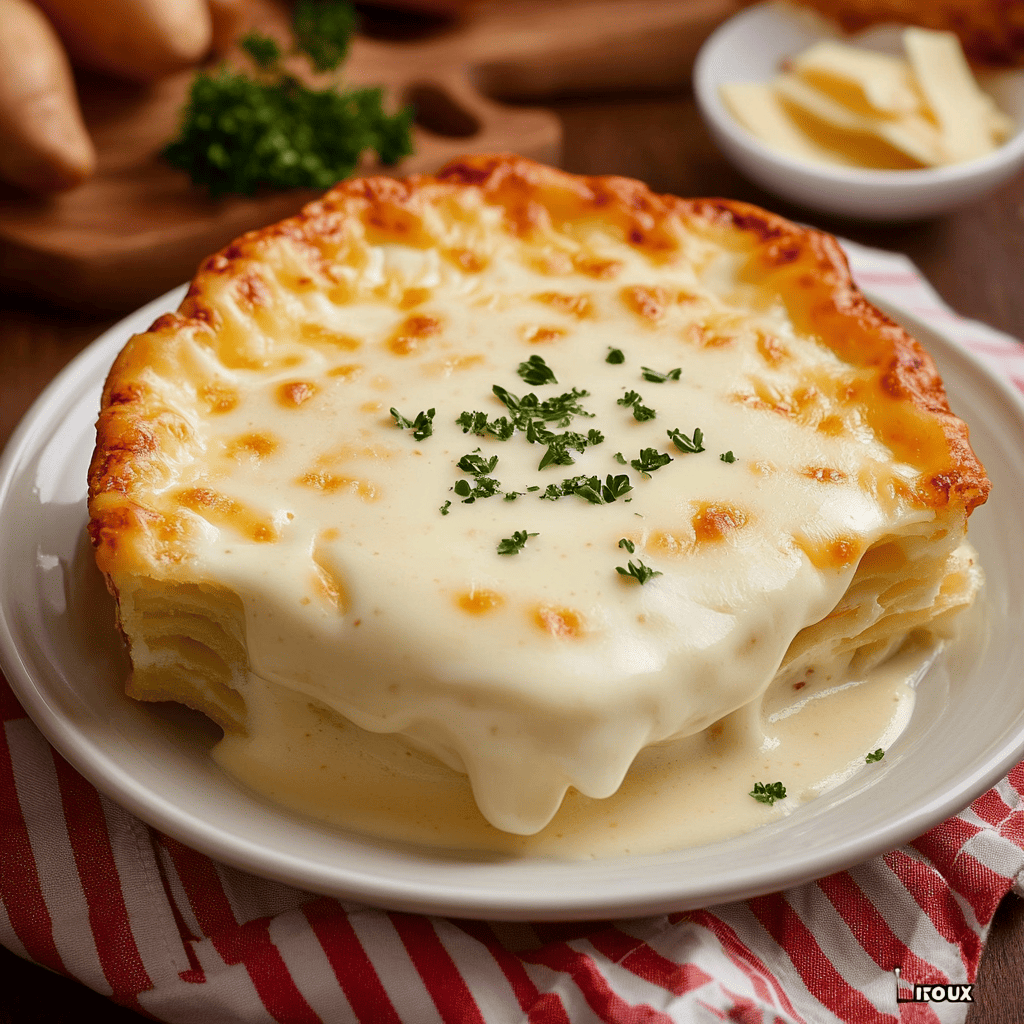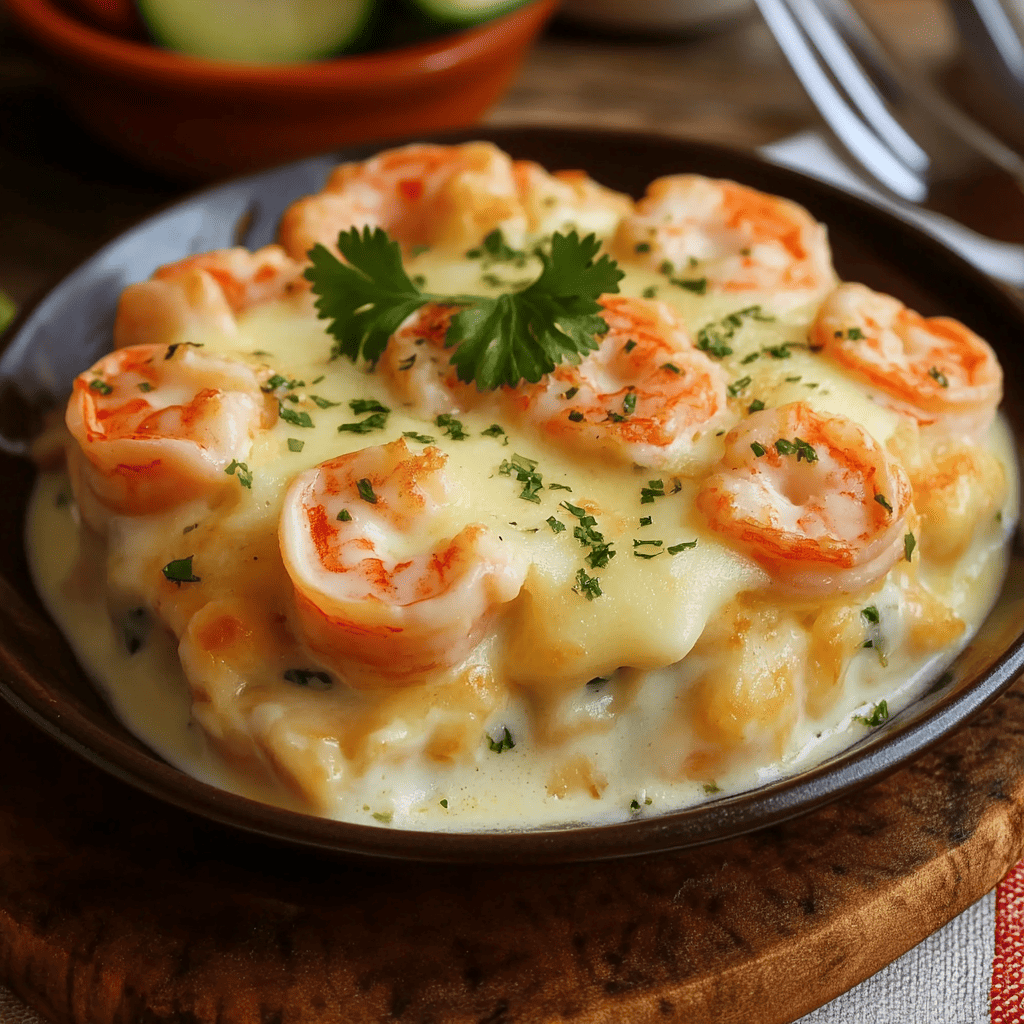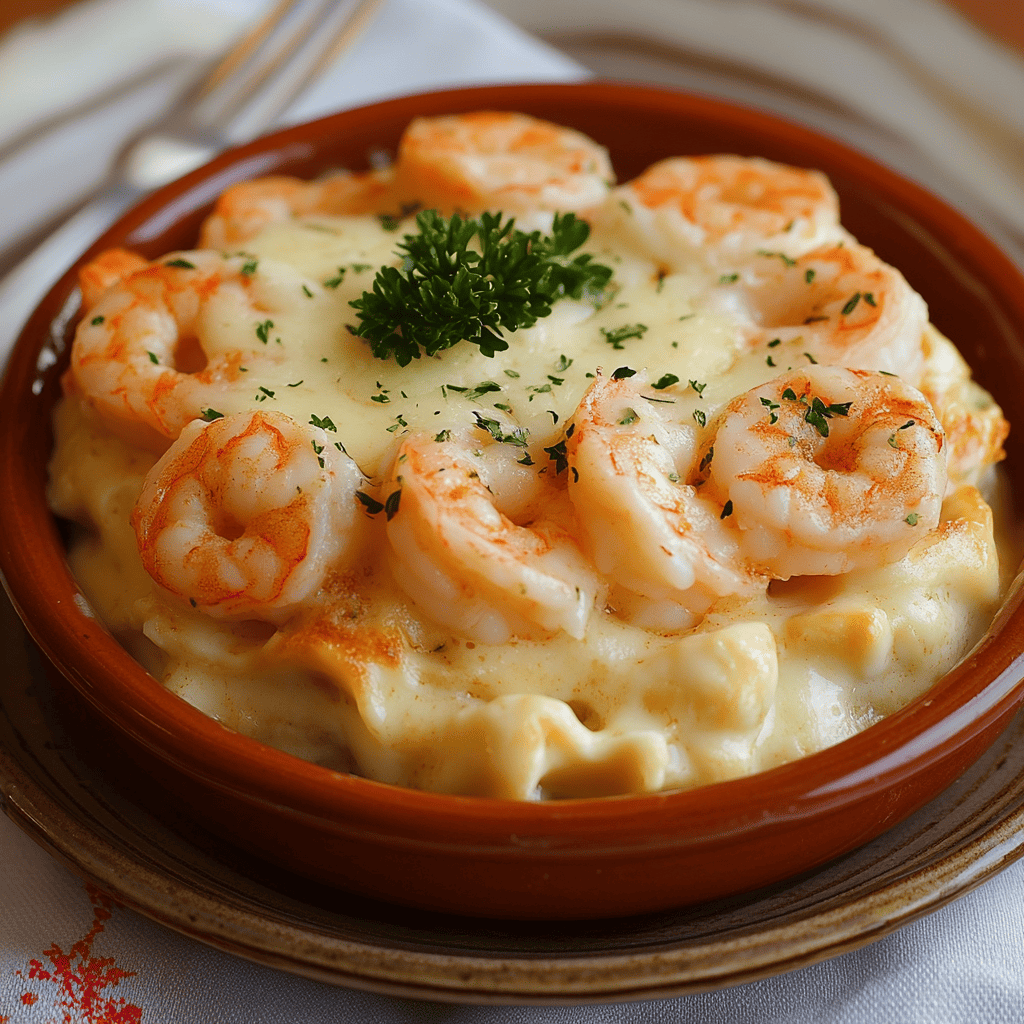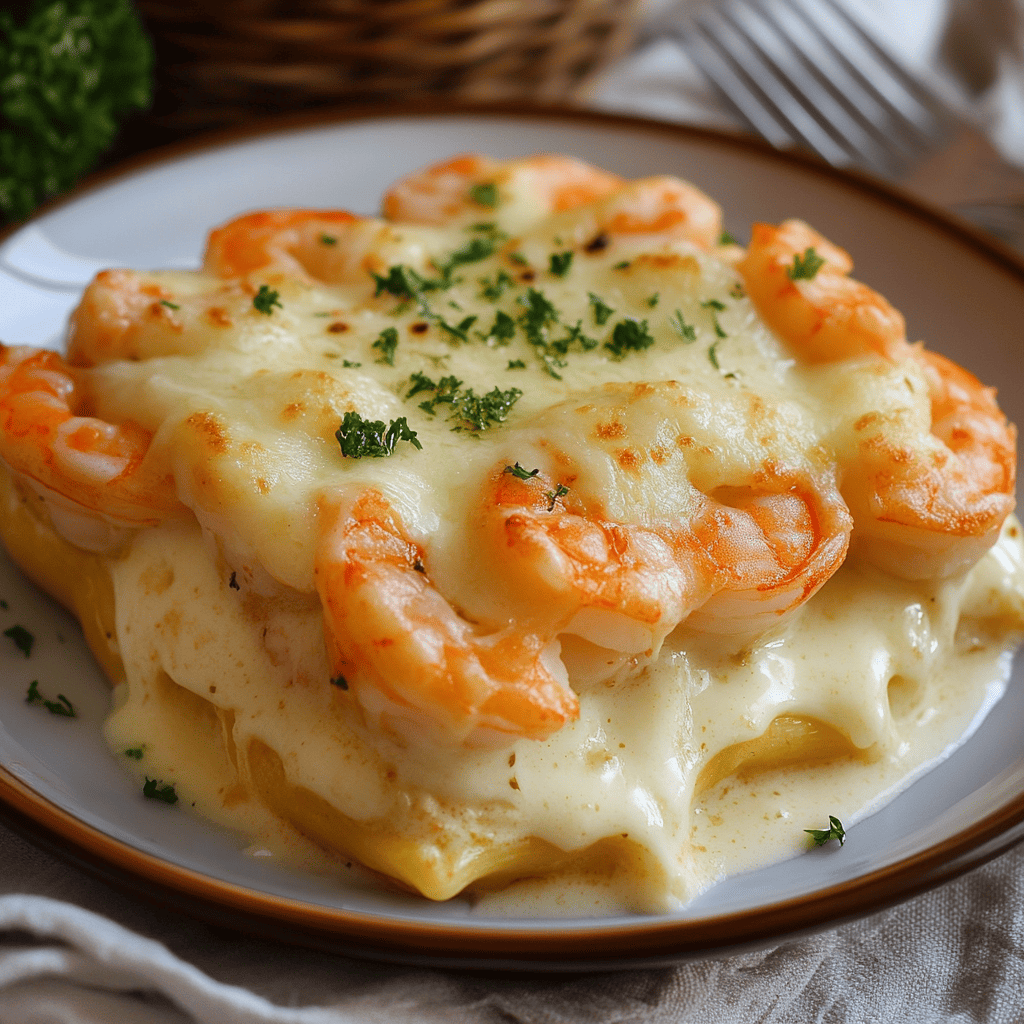Shrimp Lasagna with White Sauce and Cheese: A Seafood Delicacy That Delights the Palate
Introduction: The Culinary Art of Lasagna
Lasagna, that iconic dish of Italian cuisine, has transcended borders and cultures, adapting to the tastes and resources of each region. While the classic meat version is universally beloved, “Shrimp Lasagna with White Sauce and Cheese” represents a sophisticated and delicious variation that elevates the culinary experience to new heights. Combining the delicacy of fresh shrimp with the creaminess of a béchamel sauce and the richness of a blend of gratin cheeses, this dish is a true gem for seafood and fine dining lovers. Its visual presentation is as appetizing as its taste: perfectly assembled layers, a golden brown gratin, and the vibrant color of the shrimp peeking out, promising a bite full of textures and flavors that complement each other perfectly.
Detailed History: A Journey Through Time and Flavor
The history of lasagna is as rich and complex as its layers. Although commonly associated with Italy, the etymology of the word “lasagna” dates back to the Greek “laganon,” a flat sheet of pasta cut into strips. The Romans adopted this concept to create “laganum,” a dish consisting of cooked pasta sheets layered with fillings. However, it wasn’t until the Middle Ages in Italy that lasagna began to take the form we know today, evolving in different regions with local ingredients.
The Emilia-Romagna region, particularly Bologna, is widely credited with popularizing lasagna with meat ragù and béchamel, making it a signature dish of its cuisine. However, lasagna’s versatility has allowed for its adaptation and enrichment. The addition of seafood, such as shrimp, is a more recent innovation, driven by the coastal regions’ proximity to marine resources and the creativity of chefs.
Shrimp Lasagna has no single, precisely documented date or place of origin. Rather, it is the result of a natural evolution of Italian cuisine and its global influence. As seafood became more accessible and valued, and lasagna established itself as an adaptable dish, the fusion of the two elements became inevitable. Chefs in coastal regions of Italy, or even in home kitchens, likely experimented with adding shrimp to traditional lasagna, seeking a light and flavorful alternative to meat-based versions. This variation became popular in restaurants and homes, especially during celebrations and special occasions, given the perception of seafood as more luxurious ingredients. The addition of white sauce (béchamel) and a generous layer of melted cheese, elements already present in traditional lasagna, provided the creaminess and umami flavor needed to balance the delicacy of the shrimp.
More Details of the Story: The Globalization of a Classic
Over time, shrimp lasagna has transcended Italy’s borders and become a beloved dish in cuisines around the world, especially in countries with a strong maritime culinary tradition or a large Italian-American community. In Latin America, for example, where shrimp is a common and highly prized ingredient, shrimp lasagna has found a special place in the culinary repertoire. The recipe has been adapted to local ingredients and regional tastes, while always maintaining the essence of lasagna: layers of pasta, a creamy filling, and a cheese gratin.
This adaptation of lasagna, far from being a departure from tradition, is a testament to the evolving nature of cuisine. Dishes aren’t static; they transform and are enriched with new ideas and combinations of ingredients. Shrimp lasagna is a perfect example of how a classic dish can be reinvented to offer a fresh and exciting taste experience, without losing its original soul. It’s a dish that speaks to innovation, the richness of natural resources, and the kitchen’s ability to bring together the best of different worlds.

Ingredients: A Symphony of Flavors
White Sauce (Bechamel):
- 2 tablespoons of butter
- 2 tablespoons of wheat flour
- 1 liter of milk
- Salt to taste
- Black pepper to taste
- Nutmeg to taste
- 1 cup heavy cream (whipping cream or liquid cream)
Shrimp Filling:
- 500g of clean shrimp (without shell or vein)
- 2 tablespoons of extra virgin olive oil
- 1 medium onion, finely chopped
- 2 cloves of garlic, finely chopped
- 2 peeled and seeded tomatoes, chopped into small cubes
- 1/2 cup chopped fresh parsley
- 1/2 cup chopped fresh chives (or cilantro, if preferred)
- Salt to taste
- Black pepper to taste
Lasagna Assembly:
- 250g lasagna dough (pre-cooked or fresh)
- 300g grated mozzarella cheese
- 100g grated Parmesan cheese
Detailed Preparation: Step by Step to Culinary Perfection
Step 1: Preparing the White Sauce (Bechamel)
- In a medium saucepan over medium heat, melt the 2 tablespoons of butter.
- Once melted, add the 2 tablespoons of wheat flour. Using a wooden spoon or a whisk, cook the flour and butter together for 1-2 minutes, stirring constantly, until a golden paste called a “roux” forms. This will help eliminate the raw flour flavor.
- Remove the pot from the heat for a moment. Gradually pour the cold milk over the roux, whisking vigorously with the wire whisk to prevent lumps from forming. It’s crucial to add the milk gradually and whisk constantly to achieve a smooth sauce.
- Return the pot to medium-low heat and continue cooking, whisking constantly, until the sauce thickens and begins to bubble gently. The consistency should be creamy and opaque, not too runny.
- Season the sauce with salt, freshly ground black pepper, and a pinch of grated nutmeg to taste. Nutmeg is a classic addition that enhances the flavor of the béchamel.
- Finally, add the cup of heavy cream and mix well. Cook for one more minute and then remove from heat. Cover the surface of the sauce directly with plastic wrap to prevent a skin from forming while you prepare the filling.
Step 2: Preparing the Shrimp Filling
- Make sure the shrimp are clean, peeled, and deveined. If they’re large, you can cut them in half for more even distribution in the lasagna.
- In a large skillet over medium-high heat, heat the 2 tablespoons of olive oil.
- Add the chopped onion and cook until translucent and lightly browned, about 5-7 minutes.
- Add the minced garlic and cook for 1 more minute, until fragrant. Be careful not to burn it, as this will make the flavor bitter.
- Add the chopped tomatoes to the pan. Cook for about 5 minutes, stirring occasionally, until the tomatoes soften and release their juices, forming a sauce-like consistency.
- Add the shrimp to the pan. Cook for just 2-3 minutes, or until they turn a dull pink and curl slightly. It’s essential not to overcook the shrimp, as they will become rubbery.
- Remove the pan from the heat. Add the chopped parsley and chives. Season with salt and black pepper to taste. Mix everything gently. Set aside.
Step 3: Assembling the Lasagna
- Preheat oven to 180°C (350°F).
- If you’re using lasagna dough that requires pre-cooking, boil it according to the package instructions. If you’re using pre-cooked or fresh dough, you can use it straight away.
- In a baking dish (approximately 20×30 cm), spread a thin layer of white sauce on the bottom. This will prevent the pasta from sticking and help it cook evenly.
- Place a layer of lasagna dough sheets over the sauce, covering the entire bottom. You can overlap the sheets slightly if necessary.
- Spread about one-third of the shrimp filling over the pasta layer.
- Cover the shrimp with a generous layer of white sauce.
- Sprinkle some of the grated mozzarella cheese and a little grated Parmesan cheese.
- Repeat the layers: pasta, shrimp filling, white sauce, and cheese, until all the ingredients are gone. Finish with a layer of pasta, generously topped with the remaining white sauce and a generous amount of grated mozzarella and Parmesan cheese.
- Optional: If you like, you can sprinkle a little more fresh chopped parsley over the top layer before baking for a touch of color.
Step 4: Baking
- Cover the dish with aluminum foil. This helps the lasagna cook evenly and prevents the surface from browning too quickly.
- Bake for 20-25 minutes with the foil on.
- Remove the foil and bake for another 15-20 minutes, or until the top is golden brown and bubbly, and the cheese is completely melted and browned.
- Once baked, remove the lasagna from the oven and let it rest for at least 10-15 minutes before slicing and serving. This resting time is crucial for the layers to set and for the lasagna to hold its shape when portioned.
Estimated Preparation Time
- Active Preparation: 45-60 minutes
- Cooking Time (Oven): 35-45 minutes
- Resting Time: 10-15 minutes
- Estimated Total Time: 1 hour 30 minutes – 2 hours
Additional Tips for a Perfect Lasagna
- Ingredient Quality: Use fresh, high-quality shrimp. The difference in flavor is noticeable. For the white sauce, whole milk and good butter will make a difference.
- Preventing Lumps in Béchamel: When adding milk to the roux, make sure the milk is cold and add it gradually while whisking vigorously. This will prevent lumps from forming.
- Don’t Overcook Shrimp: Shrimp cook very quickly. Cook them only until they change color; they’ll finish cooking in the oven. Overcooked shrimp are rubbery.
- Lasagna Dough: If you use fresh pasta, your lasagna will have a more tender texture. If you use pre-cooked pasta, make sure there’s enough moisture in the sauce for it to hydrate properly.
- Crucial Rest: Don’t underestimate the rest time. Allow the lasagna to settle so the layers compact and it’s easier to cut and serve without falling apart.
- Cheese Variations: While mozzarella and Parmesan are classics, you can experiment with other cheeses that melt well and complement the flavor of the seafood, such as provolone or Gruyère.
- Optional Spicy: For a spicy kick, you can add a pinch of red chili flakes to the shrimp filling.
- Freezing: Shrimp lasagna can be prepared in advance and frozen before or after baking. If freezing unbaked, thaw completely in the refrigerator before baking and adjust the cooking time accordingly.

Frequently Asked Questions and Clear Answers
- Can I use frozen shrimp? Yes, but be sure to thaw them completely and drain them well before cooking to avoid excess water in the filling.
- Can it be made gluten-free? Yes, there are gluten-free lasagna doughs available on the market. Also, make sure the flour for the béchamel is gluten-free (for example, rice flour or cornstarch).
- How long does it last? Refrigerated in an airtight container, shrimp lasagna keeps well for 3-4 days. It can be reheated in the oven or microwave.
- What side dish do I recommend? A fresh green salad with a light dressing is the perfect accompaniment to balance the richness of the lasagna. A nice crusty bread to dip in the sauce is also a great option.
- Can I make the béchamel sauce in advance? Yes, the béchamel sauce can be made one or two days in advance and stored in the refrigerator. When ready to use, warm it gently and whisk to restore its creaminess.
Texture and Flavor: A Multisensory Experience
Shrimp Lasagna with White Sauce and Cheese is a dish that offers a rich and complex sensory experience.
- Texture: Each bite is a symphony of textures. The pasta is tender and slightly al dente, providing a solid base. The white sauce is velvety and enveloping, while the shrimp are firm yet tender, with a slight pop when you bite into them. The layer of melted cheese on top adds a delicious contrast, crisp at the edges and elastic and melting in the center.
- Flavor: The flavor is predominantly creamy and umami, with sweet and savory notes that balance each other perfectly. The shrimp provide a natural sweetness and a fresh sea flavor, enhanced by the hint of garlic and onion. The smooth white sauce, lightly spiced with nutmeg, complements the delicacy of the seafood. The mozzarella and Parmesan cheeses add a salty depth and a nutty flavor, with the Parmesan providing that characteristic spicy and robust note. Fresh parsley and chives provide a herbaceous note that lightens the dish and adds a touch of freshness.
Consumption Context: When to Enjoy It?
This lasagna is a versatile dish, ideal for various occasions:
- Family Meal: It’s a comforting and hearty dish, perfect for a weekend family meal.
- Celebrations and Parties: Its elegance and flavor make it suitable for special occasions, dinners with friends, or festive gatherings. It can be the main course at a more formal dinner.
- Romantic Dinners: A well-presented portion of this lasagna can be an impressive dish for a special dinner for two.
- Make Ahead: This is a great meal prep dish if you want to have a delicious meal ready to reheat during the week.
Visual Aspect: A Culinary Work of Art
Shrimp lasagna is visually appealing, especially the gratin version pictured.
- Defined Layers: The different layers of paste, which act as a canvas, are clearly visible.
- Color Contrast: The creamy white of the sauce contrasts beautifully with the vibrant orange-pink color of the shrimp, which stand out among the layers.
- Golden Gratin: The top layer of gratin cheese is an appetizing golden color, with bubbles of melted cheese that suggest the creaminess inside.
- Green Touch: Sprinkling fresh chopped parsley over the gratin adds a vibrant color contrast and a touch of freshness that invites tasting.
- Presentation: A well-cut portion on a plate, as seen in the image, highlights the architecture of the dish and its richness.
Fun Facts: Interesting Facts about Lasagna and Shrimp
- World’s Largest Lasagna: The record for the world’s largest lasagna was set in 2012 in Poland, weighing over 4.8 tons and requiring over 20,000 sheets of pasta.
- Shrimp Varieties: There are thousands of shrimp species, but only a few are consumed by humans. White, pink, and tiger shrimp are the most common in cooking.
- Benefits of Shrimp: They are an excellent source of lean protein, low in calories, and rich in vitamins B12 and D, as well as minerals such as selenium and iron.
- Origin of Béchamel: Although popularized in French cuisine, béchamel sauce has Italian roots, where it was known as “salsa colla” or “mother sauce.” It was Catherine de Medici who brought it to France.
- Lasagna in Different Cultures: In Venezuela, lasagna is often known as “pasticho” and can include meat or chicken stews, often with yellow cheese. In Argentina, lasagna is a festive dish, and seafood versions are increasingly popular.
Nutritional Value (Estimated per Serving)
It’s important to remember that nutritional values are approximate and can vary significantly depending on the brand of ingredients and the exact serving size. For a serving of shrimp lasagna (approximately 300-350g), we could estimate:
- Calories: 500-700 kcal (depending on the amount of cheese and sauce)
- Protein: 30-40g (high in protein due to shrimp and cheese)
- Total Fat: 30-45g (includes saturated fat from butter, cream, and cheeses)
- Carbohydrates: 30-40g (mainly from the pasta and a little from the milk and flour)
- Fiber: 2-4g (from vegetables)
- Sodium: 800-1200mg (varies depending on added salt and type of cheese)
- Cholesterol: 200-300mg (mainly from shrimp and dairy)
Additional Benefits and Interesting Facts
- Source of Selenium: Shrimp is one of the best food sources of selenium, an essential mineral that acts as a powerful antioxidant and supports thyroid function.
- Rich in Omega-3: Although in smaller quantities than other seafood, shrimp provide Omega-3 fatty acids, which are beneficial for cardiovascular and brain health.
- Vitamin B12: Crucial for nerve function and red blood cell production.
- Complete Dish: Shrimp lasagna is a nutritionally complete dish, offering carbohydrates, protein, and fat in one meal, making it very satisfying.
- Versatility: Although the recipe is specifically for shrimp, the concept is adaptable. You can experiment with other seafood such as scallops, squid, or a combination of both.
Other Information
- Allergies: This dish contains seafood (shrimp), dairy (milk, butter, cream, cheese), and gluten (wheat flour and pasta). It’s important to consider these common allergies when preparing or serving.
- Storage: For best storage, store leftovers in an airtight container in the refrigerator. You can reheat in the oven at 160°C (325°F) until hot, or in the microwave.
- Customization: Feel free to adjust the ingredient amounts to your liking. If you like more cheese, add more. If you prefer a more intense seafood flavor, you can use shrimp broth for part of the béchamel sauce.

Conclusion: A Feast for the Soul and the Palate
Shrimp Lasagna with White Sauce and Cheese is much more than a simple dish; it’s a celebration of cuisine, a fusion of tradition and creativity that delights all the senses. From the careful preparation of each layer to the moment its aroma fills the kitchen and its golden brown au gratin invites you to take the first spoonful, this lasagna promises an unforgettable culinary experience. It’s a dish that speaks of comfort, elegance, and the joy of sharing a good meal. Whether for a special occasion or simply as a treat, this lasagna is a sure bet that will leave everyone wanting more. Its history, its richness of flavors and textures, and its versatility make it a modern classic that deserves a place of honor in any recipe book.

